
PREV ARTICLE
NEXT ARTICLE
FULL ISSUE
PREV FULL ISSUE
SELECTIONS FROM THE STACK'S BOWERS ANA RARITIES SALE
Here are some coins that caught my eye in the catalog of the upcoming Stack's Bowers Rarities Night sale, August 13, 2015. -Editor
Lot 10008: 1817 Texas Jola
 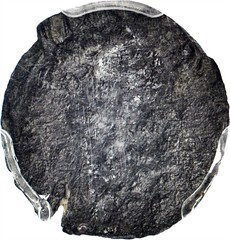
In the early nineteenth century, the Southwest region of North America was part of the Viceroyalty of New Spain, which administered a huge swath of land including that which now constitutes the state of Texas. On March 29, 1817, the Acting Governor Manuel Pardo posted notice that "our neighbor Don Manuel Barrera having petitioned to this government the milling of fifteen hundred pesos in total containing his name and surname; this government has accepted this individual's solicitation to mill fifteen hundred pesos in total, with a value of half a real for each." This order represents the first such authorization to produce Spanish colonial coinage in what is now the United States. With a peso being the equivalent of an eight reales silver coin, this would represent a production order of 24,000 such coins, though this number has been in dispute, with some sources indicating that only 8,000 jolas were authorized. Barrera, a local merchant and jeweler in San Antonio de Bexar, began striking the half real pieces using hand cut dies on crudely fashioned copper planchets with angled edges. Several designs were employed but none were elaborate. One version bears the legend M. BARRERA, the denomination 1/2 and AD1817, and another, much more simple that simply reads M.B. and the date 1817. On May 27, 1817, Acting Governor Pardo relinquished his command to Antonio Maria Martinez who served as Governor of New Spain until August 17, 1822. In December 1818, Martinez issued a recall notice for the Barrera jolas in favor of a new issue to be produced by Jose Antonio de la Garza. The coins issued by de la Garza were the much better known J.A.G. 1818 jolas, which appear to have been designed in imitation of the simpler Barrera jolas. For decades, the 1817 jolas were more mythical and while documentary evidence for their existence had been known, the coins themselves were largely unknown. In the early 1960s, scattered reports of metal detector finds surfaced from time to time hinting at the 1817 dated coins. It was not until James Bevill's book The Paper Republic came out in 2009 were the coins first widely published and made known to a broader numismatic audience and later expanded in the May 2011 edition of The Numismatist by Bevill and Alvin Stern. The story of the 1817 and 1818 jolas can now be pieced together with a lot more accuracy, though much research no doubt remains. Today the Texas jolas have begun to shed their cloak of mystery and reveal the fascinating story behind these historic piece of early American history. Eminently collectible in any grade, this is a series awaiting further study and appreciation.
I remember the day Bob Metzger handed me a Jola and asked what I thought of it. Having never seen one in person I wasn't entirely
sure, but my gut told me that particular piece was a counterfeit - probably a cast copy. I didn't quite know what to say, though.
It's like asking if someone is pregnant - you'd better know the answer before you ask, or things get awkward fast. I was relieved
to know Bob felt the same way about that piece, which a fellow club member had asked him to bring to the ANA convention for examination.
But while that one was a copy, I do believe several pieces are the real deal. I think the physical and documentary evidence points to
that, and as the cataloguer states, the fog surrounding these crude, enigmatic issues is clearing. The Jola is one of my favorite coins.
-Editor
To read the complete lot description, see:
Lot 10296: 1919 Buffalo Nickel--Double Struck
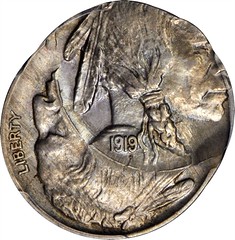 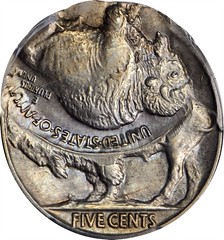
A visually dramatic and consequently extremely rare Mint error in a Buffalo nickel. The second strike is off center at 1 o'clock, but it is located at approximately the 6 o'clock position relative to the first impression. The result is that both sides display partial designs that are nearly upside down relative to each other. The only date visible is that from the second strike, and all design elements that are present are sharply defined and clear. Evenly toned in soft pearl gray, flickers of baby blue iridescence are also evident in isolated areas as the surfaces rotate under a light. A lovely piece, and a coin that is sure to catch the eye of advanced Buffalo nickel collectors and error specialists alike.
Wow - this is a striking piece. Normal Buffalo Nickels can easily be found, even in top condition, but errors like this are very rare,
and in this case, beautiful. Fascinating. -Editor
To read the complete lot description, see:
Lot 10300: 1849 Massachusetts & California Co. $5 Trial
 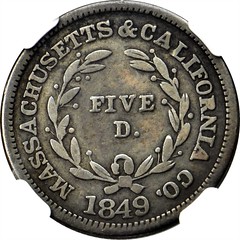
Another enigmatic early private coining operation, as was first reported by Edgar Adams using contemporary accounts, the Massachusetts & California Company was established in January 1849 in Northampton, Massachusetts with the intent to assay and coin money in the gold producing region and was even compared to the Bechtler mint in North Carolina. According to additional newspaper accounts, members of the company as well as their coining equipment were reportedly loaded aboard the Alice Tarlton on May 21 and set sail for San Francisco. However, nothing further is heard about the Massachusetts & California Company nor their coins. Breen suggests that these extremely rare trials were struck in Massachusetts as a demonstration of the company's capabilities using various metals, including silver, though none appear to have ever been struck in gold... All examples of these die trials are of the highest rarity. As one of the few tangible relics of this ephemeral Gold Rush company, it is of prime historical interest for the dedicated student of the California Gold Rush. To read the complete lot description, see:
Lot 10301: 1849 Pacific Company Pattern $2.50.
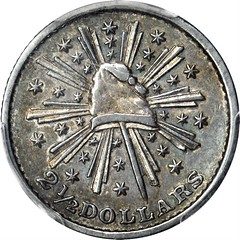 
The issues of the Pacific Company have baffled and intrigued scholars for decades. It is thought that the "Pacific Company" organized by Boston merchant John W. Cartwright in January of 1849 might be the leading contender as issuers of a series of enigmatic coins all dated 1849. After arriving in San Francisco and then Benicia in September, the company dissolved scarcely one month later. Some recent research has shown that the dies for these coins may have been prepared in the East and arrived to California with the members of the company. When the Pacific Company disbanded shortly after arriving, the dies appear to have come into the possession of assaying firm Broderick & Kohler in San Francisco, who then used the dies to produce a series of gold coins at relatively low purity for general circulation. The half eagles and eagles produced in gold were shown by U. S. Mint assays to have an intrinsic value of $4.48 and a surprisingly low $7.76, respectively, and were promptly rejected in circulation except at a steep discount. Most ended up in the melting pot and now only a mere handful of gold coins and a series of silver and base metal patterns remain. While a gold dollar has been discovered, so far no gold $2.50 pieces are known and quite possibly were not struck. When we (Stack's) offered the Roper Collection silver $2.50 pattern back in 1983 it was noted that the piece was overstruck on a dime. While it is most likely that these silver patterns were struck on dimes or similar sized foreign coin (a possibility that makes sense if the pieces were struck in the West), so far the evidence has proven to be inconclusive. A first class rarity by any measure, the pedigree of the present specimen to the legendary Garrett Collection only adds to its historic importance and will no doubt elicit considerable attention to Gold Rush specialists.
Another interesting and rare gold rush era issue, and with a Garrett pedigree, too. -Editor
To read the complete lot description, see:
Before closing I'll state one of my pet peeves about some coin images these days - for heaven's sake, get a photo BEFORE it goes
into a slab, so you can publish images of the complete coin without those ugly slivers of plastic that hold them in place. Few of these
images are of the complete coin. That's not directed at any one auction firm, but it's lamentably part of the landscape today.
But even worse are the photoshopped images in various publications, where shadows are added or coins are overlapped to make a more artsy
picture. They're pretty and there's nothing wrong with them, but only if you also include in the article actual untouched images
of the real coin that can be relied on by a researcher. -Editor
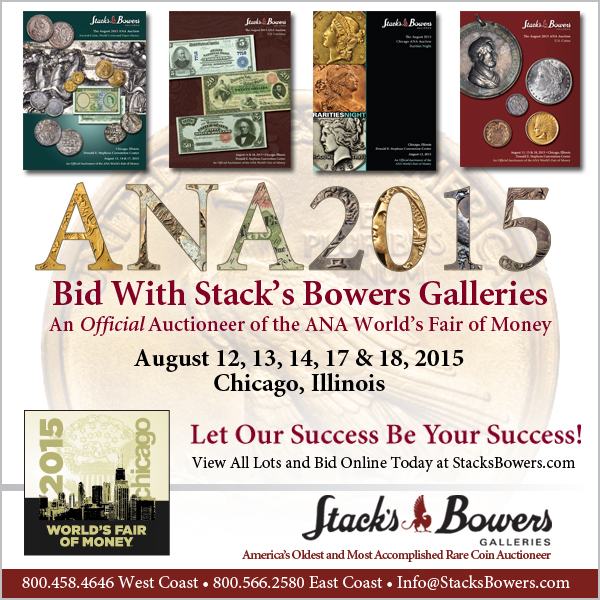
Wayne Homren, Editor The Numismatic Bibliomania Society is a non-profit organization promoting numismatic literature. See our web site at coinbooks.org. To submit items for publication in The E-Sylum, write to the Editor at this address: whomren@gmail.com To subscribe go to: https://my.binhost.com/lists/listinfo/esylum All Rights Reserved. NBS Home Page Contact the NBS webmaster 
|